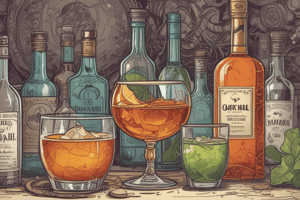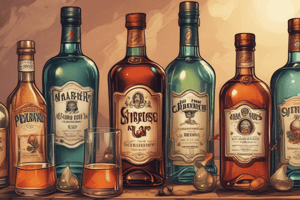Podcast
Questions and Answers
Which of the following is NOT a use of spirits?
Which of the following is NOT a use of spirits?
- Therapeutic value of aromatic solutes
- Topical applications
- Flavoring agents
- Preservatives (correct)
What is the primary role of alcohol in the formulation of the Compound Orange Spirit?
What is the primary role of alcohol in the formulation of the Compound Orange Spirit?
- Preservative
- Solvent (correct)
- Flavoring agent
- Carminative
Which of the following ingredients is NOT included in the preparation of Compound Orange Spirit?
Which of the following ingredients is NOT included in the preparation of Compound Orange Spirit?
- Oil of anise
- Oil of lemon
- Oil of peppermint (correct)
- Oil of coriander
What type of products are elixirs primarily classified into?
What type of products are elixirs primarily classified into?
What is the typical alcoholic content range of elixirs?
What is the typical alcoholic content range of elixirs?
Which ingredient is primarily responsible for the sweetness in elixirs?
Which ingredient is primarily responsible for the sweetness in elixirs?
In the context of spirits, what does the term 'pungency' refer to?
In the context of spirits, what does the term 'pungency' refer to?
Which of the following is a function of glycerin in elixirs?
Which of the following is a function of glycerin in elixirs?
Which spirit is specifically used topically for relief of minor pains and aches?
Which spirit is specifically used topically for relief of minor pains and aches?
Which chemical characteristic distinguishes elixirs from spirits?
Which chemical characteristic distinguishes elixirs from spirits?
What is the primary reason for adding the aqueous solution to the alcoholic solution rather than the reverse when preparing elixirs?
What is the primary reason for adding the aqueous solution to the alcoholic solution rather than the reverse when preparing elixirs?
Which component is used in the preparation of Phenobarbital Elixir to absorb excessive oils during filtration?
Which component is used in the preparation of Phenobarbital Elixir to absorb excessive oils during filtration?
How much of the total volume is constituted by the liquid ingredients in the preparation of Phenobarbital Elixir?
How much of the total volume is constituted by the liquid ingredients in the preparation of Phenobarbital Elixir?
What is the purpose of glycerin in the Phenobarbital Elixir formulation?
What is the purpose of glycerin in the Phenobarbital Elixir formulation?
In the preparation of a 1000 ml Phenobarbital Elixir, what is the total volume of solvent required?
In the preparation of a 1000 ml Phenobarbital Elixir, what is the total volume of solvent required?
What role does the tincture of orange peel play in the Phenobarbital Elixir formulation?
What role does the tincture of orange peel play in the Phenobarbital Elixir formulation?
Which ingredient is NOT a component of the Phenobarbital Elixir?
Which ingredient is NOT a component of the Phenobarbital Elixir?
What is the total volume of the mixed Phenobarbital Elixir after all components are combined?
What is the total volume of the mixed Phenobarbital Elixir after all components are combined?
Why is it important to let the elixir stand if cloudiness occurs?
Why is it important to let the elixir stand if cloudiness occurs?
What component of the Aromatic Elixir USP is used as a thickening agent?
What component of the Aromatic Elixir USP is used as a thickening agent?
What is the total volume of liquid ingredients used in the preparation of the solution?
What is the total volume of liquid ingredients used in the preparation of the solution?
How much of the co-solvent is required for the dissolution process?
How much of the co-solvent is required for the dissolution process?
Which component serves as a sweetening agent in the mixture?
Which component serves as a sweetening agent in the mixture?
In the preparation of 5 ml of alcohol 70%, how much alcohol 90% is required?
In the preparation of 5 ml of alcohol 70%, how much alcohol 90% is required?
What is the final step after filtering the resultant solution?
What is the final step after filtering the resultant solution?
What role does talc powder play in the preparation process?
What role does talc powder play in the preparation process?
Which equation is utilized to prepare the 5 ml of alcohol 70%?
Which equation is utilized to prepare the 5 ml of alcohol 70%?
What is the volume of co-solvent prepared in the solution preparation process?
What is the volume of co-solvent prepared in the solution preparation process?
What is done with the talc powder after it is weighed and transferred to the beaker?
What is done with the talc powder after it is weighed and transferred to the beaker?
Which of the following components is used as a flavoring agent in the solution?
Which of the following components is used as a flavoring agent in the solution?
Flashcards
Spirit (Pharmaceutical)
Spirit (Pharmaceutical)
An alcoholic or hydroalcoholic solution of volatile substances, often used as flavorings or medicinally.
Alcohol Concentration (in Spirits)
Alcohol Concentration (in Spirits)
Usually above 60% alcohol by volume.
Aromatic Ammonia Spirit Use
Aromatic Ammonia Spirit Use
Used orally as a carminative and antacid; inhaled for fainting episodes.
Camphor Spirit Use
Camphor Spirit Use
Signup and view all the flashcards
Compound Orange Spirit
Compound Orange Spirit
Signup and view all the flashcards
Elixir (Pharmaceutical)
Elixir (Pharmaceutical)
Signup and view all the flashcards
Elixir Main Ingredients
Elixir Main Ingredients
Signup and view all the flashcards
Elixir's Alcohol Content
Elixir's Alcohol Content
Signup and view all the flashcards
Elixir Types
Elixir Types
Signup and view all the flashcards
Compound orange spirit components
Compound orange spirit components
Signup and view all the flashcards
Elixir Preparation
Elixir Preparation
Signup and view all the flashcards
Alcoholic Strength
Alcoholic Strength
Signup and view all the flashcards
Separation (Elixir)
Separation (Elixir)
Signup and view all the flashcards
Filter Aid (Elixir)
Filter Aid (Elixir)
Signup and view all the flashcards
Phenobarbital Elixir Components
Phenobarbital Elixir Components
Signup and view all the flashcards
Solvent Calculation (Elixir)
Solvent Calculation (Elixir)
Signup and view all the flashcards
Aromatic Elixir Ingredients
Aromatic Elixir Ingredients
Signup and view all the flashcards
Dissolution Method (Elixir)
Dissolution Method (Elixir)
Signup and view all the flashcards
Final Volume Adjustment
Final Volume Adjustment
Signup and view all the flashcards
Elixir Labeling
Elixir Labeling
Signup and view all the flashcards
What is the purpose of talc powder in the formula?
What is the purpose of talc powder in the formula?
Signup and view all the flashcards
Why is alcohol used in this formula?
Why is alcohol used in this formula?
Signup and view all the flashcards
What is the role of compound spirit of orange in the preparation?
What is the role of compound spirit of orange in the preparation?
Signup and view all the flashcards
What is the purpose of preparing a co-solvent?
What is the purpose of preparing a co-solvent?
Signup and view all the flashcards
What is the significance of the 'a.a.q.s' abbreviation?
What is the significance of the 'a.a.q.s' abbreviation?
Signup and view all the flashcards
Why is it important to filter the solution after mixing?
Why is it important to filter the solution after mixing?
Signup and view all the flashcards
How is the final volume of the solution achieved?
How is the final volume of the solution achieved?
Signup and view all the flashcards
What is the main difference between an elixir and a spirit?
What is the main difference between an elixir and a spirit?
Signup and view all the flashcards
Do elixirs and spirits require preservatives?
Do elixirs and spirits require preservatives?
Signup and view all the flashcards
What is the primary use of a spirit in pharmacy?
What is the primary use of a spirit in pharmacy?
Signup and view all the flashcards
Study Notes
Pharmaceutical Technology: Spirits & Elixirs
- Spirits are alcoholic or hydroalcoholic solutions of volatile substances. Generally, the alcoholic concentration is usually over 60%. Sometimes they are called essences.
- Spirits can be used pharmaceutically as flavoring agents or medicinally for the therapeutic value of aromatic solutes. They can be taken orally (often mixed with water to reduce pungency), applied topically, or inhaled.
- Common spirits include:
- Aromatic ammonia spirit (oral carminative & antacid, inhalation for fainting)
- Camphor spirit (topical relief for minor pains & aches)
- Compound orange spirit (oral flavoring agent)
- Peppermint spirit (oral carminative & flavoring agent)
- Compound Orange Spirit contains:
- Oil of orange (20ml)
- Oil of lemon (50ml)
- Oil of coriander (20ml)
- Oil of anise (5ml)
- Alcohol (q.s 1000ml)
Compound orange spirit procedure
- Combine 20ml oil of orange, 50ml oil of lemon, 20ml oil of coriander and 5ml oil of anise.
- Add enough alcohol to bring the total volume up to 1000ml.
- Transfer the mixture to a clean, dry container.
- Label the container.
Compound orange spirit uses
- Oil of orange: flavoring agent
- Oil of lemon: flavoring agent
- Oil of coriander: flavoring agent
- Oil of anise: flavoring, carminative, & mild expectorant
- Alcohol: solvent & preservative
Elixirs
- Elixirs are clear, sweetened hydroalcoholic solutions intended for oral use. They are flavored to improve palatability.
- Main ingredients in elixirs are ethanol and water, often with glycerin and propylene glycol as adjunct solvents, and sucrose, saccharine, sorbitol as sweetening agents, and flavoring and coloring agents.
- Elixirs can be categorized as non-medicated or medicated.
- Alcoholic content in elixirs is typically 4-40%, but enough to keep volatile oils or medicinal substances in solution.
- Many elixirs are self-preserving, needing no preservatives or antimicrobial agents.
- Elixirs are usually prepared by mixing liquid ingredients, or by dissolving alcohol-soluble and water-soluble components separately and then combining solutions.
Phenobarbital Elixir
- Ingredients and quantities:
- Phenobarbital (4g)
- Tincture of orange peel (30ml)
- Amaranth solution (10ml)
- Alcohol (125ml)
- Glycerin (150ml)
- Syrup (250ml)
- Distilled water (q.s 1000ml)
- Directions:
- Weigh and transfer phenobarbital
- Measure and combine other ingredients
- Dissolve phenobarbital in alcohol
- Add remaining ingredients
- Mix well and, if needed, filter
Phenobarbital Elixir uses
- Phenobarbital: sedative & hypnotic
- Tincture of orange peel: flavoring agent
- Amaranth solution: coloring agent
- Alcohol: solvent
- Glycerin: thickening agent, increases phenobarbital solubility
- Syrup: sweetening agent
- Distilled water: solvent
Aromatic Elixir USP
- Ingredients:
- Compound spirit of orange (12ml)
- Syrup (375ml)
- Talc powder (30g)
- Alcohol 70% (q.s 1000ml)
- Distilled water (q.s 1000ml)
- 10 ml Mitt
- Note: There is a 90% alcohol available instead.
Aromatic Elixir USP Calculations:
- A factor is used to calculate the amount required, where desired volume is divided by the total volume
Aromatic Elixir USP Procedure
- Weigh the talc powder.
- Measure compound spirit of orange and syrup
- Prepare 5 mL alcohol 70% using 3.8mL of alcohol 90%; and make up to 5mL with distilled water.
- Mix the prepared co-solvent in the beaker. Then add 0.12 mL of compound spirit of orange, 3.75 mL of syrup.
- Filter the solution.
- Transfer solution to a clean cylinder and make up volume to 10 mL with prepared solvent.
- Transfer the solution to a bottle and label.
Aromatic Elixir USP Uses
- Compound spirit of orange: flavoring agent
- Syrup: sweetening agent
- Talc powder: adsorbs excess oil
Elixir & Spirit Comparison
- This will require creating a table to compare the key properties of spirits and elixirs, including their alcoholic content, viscosity, primary solvents, need for preservatives, need for sweetening agents, and primary uses.
Studying That Suits You
Use AI to generate personalized quizzes and flashcards to suit your learning preferences.




